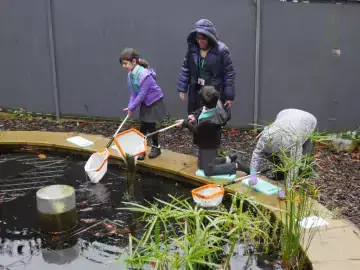
Mapping tree habitats
Mapping tree habitats is part of the Mapping your site activities, enabling you to explore and map the habitats your site currently offers for nature. Understanding your starting point is really important and will allow you to measure any nature gains you achieve when you start making enhancements to your site. Mapping tree habitats is one of eight habitat mapping sessions in this unit of learning.
Before mapping any tree habitats, the two introductory activities (found in the Mapping Tree Habitats Worksheets) have been designed to support learners in identifying the key features of trees, allowing them to answer the questions in the Trees Habitat Flowchart accurately. You'll then work together to add tree habitats on your site to the online Nature Park map.
The Tree survey supports learners to identify what type of woodland they have on their site using the flowchart. In the Habitat Mapper app groups of five or more trees are mapped as woodland. The type of woodland – broadleaf, evergreen or mixed, is determined by the proportions of the type of tree.
Meet a tree and the Tree survey can also be used as standalone activities, promoting a positive connection with nature.
You can carry out this activity at any time of year.
Getting to know your space
Preparation
Green skills
- identification and ecology
- recording data
- interpreting data
What you need
- Meet a tree and Tree survey activity sheets (in the Mapping Tree Habitats Worksheets pdf)
- Tree Habitat Flowchart
- clipboards
- drawing materials
- measuring tape or sticks
- a tablet, laptop, or desktop PC to access the online Habitat Mapper tool
- a printed map of your site, if you do not intend to use the Habitat Mapper outdoors
- optional: examples of broadleaf leaves e.g., oak, ash or beech
- optional: examples of evergreen leaves e.g., conifer tree leaves
Location
Outdoors
Useful guidance
Step by step
- Ask learners to work in small groups (three works well) to choose a tree.
- Once chosen, give learners no more than two minutes to either observe and sketch the tree, the leaves or make a bark rubbing on their worksheet. Remind them that it does not need to be perfect!
- Use the Meet a tree worksheet (in the Mapping Tree Habitats Worksheets) to guide the learners in estimating the life stage of the tree. Look at the height of the tree, the thickness of the trunk and the texture of the bark.
- Ask learners to draw the shape of the leaves and discuss whether the tree is evergreen or broadleaved using the worksheet.
- Consider what fruits, nuts or seeds the tree produces. Discuss whether humans or other animals can eat these. Do not eat any fruits or nuts unless you can positively identify them as edible, and be mindful of possible nut allergies.
- Encourage the learners to look at how the tree fits into its surroundings. Observe whether it stands alone or with other trees. If there are five or more trees in a group, complete the trees survey.
- If there are fewer than 10 trees, investigate all the trees in that area. If there are more, ask the learners to choose 10 trees at random. A random sample is important to create a fair representation of tree types within the woodland area.
- Using the Tree survey activity sheet (in the Mapping Tree Habitats Worksheets), tally the number of broadleaved and evergreen trees and use the guide to identify what kind of woodland you have.
- After completing the observations, sketches and tree survey, use the Trees Habitat Flowchart to decide which tree habitat type you should add to the Nature Park map.
- Educators can work with learners to draw each area of tree habitat onto the printed map, or (if you have internet connectivity outdoors) directly on to the online map using the Habitat Mapper tool.
- Repeat these activities for each separate area with trees on your site, as they may be different types.
- If you used a printed map, transfer the areas of tree habitats on to the Nature Park map using the Habitat Mapper tool back in the classroom. This is a really important step to ensure your site and your observations are part of national community science research.
- Return to the Mapping your site page and select the next habitat category you have on site.
Reflection
Trees are incredible living things that are a vital part of our environment. They provide shelter and habitats for other organisms, provide cooling shade, filter water, stop erosion, convert solar energy into stored carbon, provide energy when burned and are an important building material. Ask learners to reflect on their own relationship with trees when they interact with them or use them.
The type of tree influences how much light reaches the ground, how deep the leaf litter layer is and the acidity of the soil, all of which determines what organisms live in the habitat. Challenge learners to make a list of organisms that might rely on trees and ask if they saw any while surveying.
What to try next
Add other habitats to your Nature Park map

Mapping microhabitats
Begin activity
Mapping water habitats
Begin activity